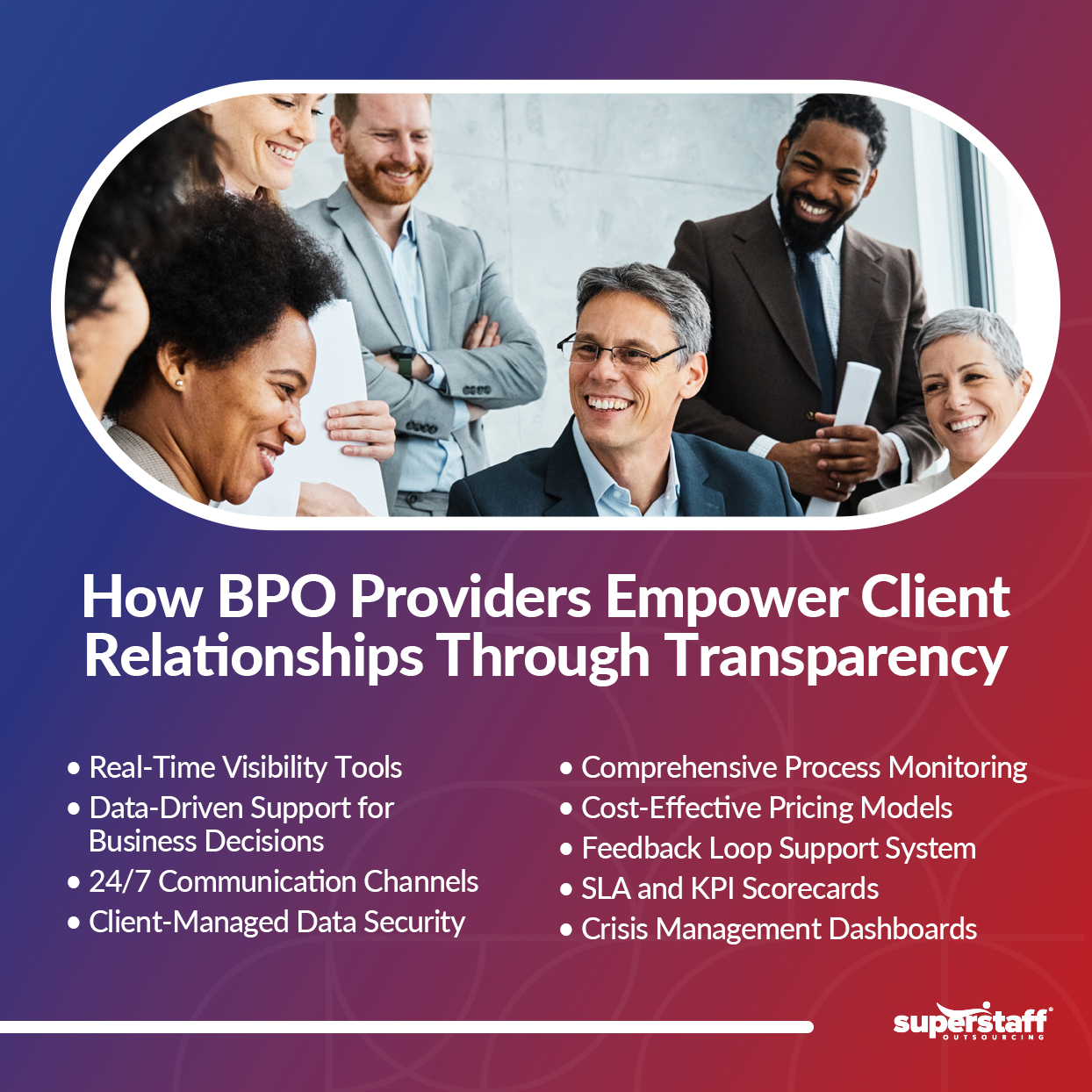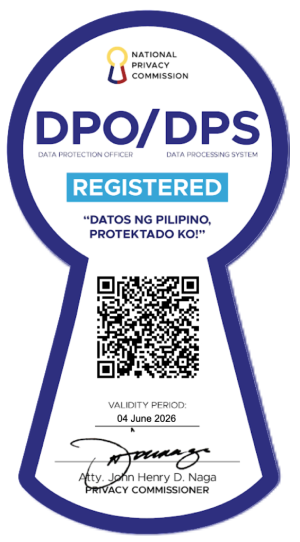
Picture a BPO partnership where every aspect of your outsourced operations is as accessible and transparent as your own in-house team. Communication between both teams would be seamless and crystal clear, leaving no room for siloes and misunderstandings.
In today’s rapidly paced business landscape, companies are no longer just seeking cost-effective outsourcing solutions. They want hands-on management, collaboration, and, of course, trust. Every outsourcing provider knows this is where transparency in Business Process Outsourcing (BPO) comes into play.
Transparency transforms BPO partnerships, empowering your business to monitor, interact, and optimize outsourced operations with unmatched clarity.
In this blog, we will explore how leading BPO service providers deliver complete operational visibility, fostering stronger, more proactive business relationships and building robust connections along the way.

The 24/7 Transparency Window of an Outsourcing Provider
Today’s top BPO providers offer a round-the-clock transparency window, giving your clients maximum access to your outsourced operations.
Through live dashboards, video feeds, and interactive reports, your business can track performance metrics in real-time, making your outsourced teams feel like an extension of your workforce. This will enable you and your outsourcing team to exchange information and workload without delays or gaps.
Studies by Slack showed that 80% of employees want to thoroughly understand workplace decisions, while 87% seek transparency from the workplaces they will eventually work in. Considering this data, how does an outsourcing provider expertly fulfill this? Let’s look at the examples and tools.
Live Dashboards
Your clients can monitor your critical Key Performance Indicators (KPIs) and performance metrics through live, user-friendly dashboards. This will give them real-time access to how their outsourced tasks are progressing, such as customer service response times, call center metrics, or project delivery statuses. KPIs are also an excellent point of reference for meeting objectives and goals.
Video Feeds Showing Workflows
Many BPO providers go a step further by offering video feeds that show workflows in real-time. These allow your clients to observe operations as they happen, providing greater insight into the processes, team dynamics, and completed tasks.
Interactive Reports Available 24/7
Your clients also have access to interactive reports that they can customize according to their needs. This round-the-clock availability of reports, coupled with detailed metrics, ensures that no question goes unanswered and that performance is always visible.
With this transparency window, businesses gain greater control and trust over outsourced operations. Your clients are no longer left in the dark; instead, they feel fully integrated into the process, which creates a foundation for mutual success.
This enables trust, empowerment, and improved productivity between your partnership and outsourced tasks. The next transparency strategy significantly connects to the transparency tools.
Insights-First Analytics from BPO Providers
BPO transparency goes beyond simply making data available or accessible. It incorporates data-driven analytics that can significantly enhance your decision-making processes and encourage them to be lighter and more manageable for clients.
Leading BPO service providers now use advanced analytics to offer predictive insights, allowing your clients to prevent problems before they arise and make proactive adjustments. Proactive updates are highly crucial to both clients and customers. According to Harvard Business Review, 70% of employees emphasize the importance of constant strategic updates from their seniors. Let’s expand upon strategies surrounding data-analytical tools.
Predictive Data on Call Volumes and Resource Needs
Predictive analytics can help forecast call volumes or workload spikes, allowing you to adjust staffing resources and scale operations to meet demand proactively. This can help prevent service disruptions, minimize downtime, and optimize performance.
Alerts on Potential Bottlenecks or Service Disruptions
BPOs can also alert your clients to potential bottlenecks or service disruptions before they escalate into issues. By receiving these proactive alerts, you can immediately resolve problems without significantly disrupting operations.
Customizable Reporting to Match Business Needs
With transparency-first analytics, your BPO partner and clients receive customizable reports tailored to specific business needs. Whether it’s monitoring financial processes or customer support workflows, these reports ensure you have all the data you and your partner need to make informed decisions.
These insights foster a proactive approach to managing operations. By empowering clients with actionable data, BPOs set a new standard in outsourcing partnerships.
The Always-On Communication Ecosystem

Effective communication is at the heart of any successful business partnership. Transparent BPOs go the extra mile to ensure that your partners remain well-informed and up-to-date on business changes.
So, how do they achieve this? It’s accomplished through an “always-on” communication ecosystem, where your clients can access direct communication channels, receive real-time updates, and resolve issues instantly.
The internet and social media have heavily influenced the business landscape, giving way to expectations of constant responses and updates. Studies by McKinsey showed that socially-focused technologies can significantly enhance communication between workers by 25%. McKinsey also elaborated that it keeps them well-connected, making it practical for fluid interactions.
Knowing this, what are excellent examples that outsourcing providers use to communicate effectively?
Dedicated Client Portals
They offer dedicated client portals where all information, from daily updates to performance metrics, is available at your discretion and your client’s fingertips. These portals are designed to be user-friendly, ensuring your clients can easily navigate them to find whatever they need without confusion.
Real-Time Escalation Channels for Immediate Support
BPOs also provide real-time escalation channels that allow your clients to raise any concerns or issues that need urgent attention immediately. Whether it’s an operational or service quality concern, they can escalate issues and receive prompt resolutions.
Regular Strategy and Performance Alignment Meetings
Transparency is not limited to just information access. Many BPOs also schedule regular meetings with clients to align on strategy, performance, and goals. These meetings help ensure that your BPO provider and client work towards the same objectives, enhancing overall collaboration.
Constant communication strengthens your collaboration, making the BPO a valid extension of your client’s team. With transparent and real-time communication, you can maintain the pulse of your outsourced operations and ensure everything is aligned with business goals, vision, and mission. Now, let’s talk about data security.
Client-Controlled Data Security
Data security is a top priority for business owners like you. The business landscape is not only competitive, it’s also crucially digital and out in the open, which can leave your business vulnerable to cyber attacks.
Transparent BPO owners you partner with and collaborate with can empower your clients by allowing them to set and monitor their data protection standards. This is crucial for handling sensitive information or operating in regulated industries.
Data by KPMG shows that an alarming 76% of business leaders like you express that cyberattacks are getting more sophisticated and dangerous. With the alarming rate of cyber threats on the horizon, it’s no surprise that your clients want more control and management over their sensitive and confidential data. With that in mind, how do BPO partners establish security checks?
Client-Customized Data Protection Controls
Leading BPOs allow clients to customize their data protection controls, tailoring security measures to their specific requirements. These controls can be adjusted accordingly if they need heightened security protocols for financial data or customer information.
Adherence to Multiple Regulatory Standards
BPOs adhere to regulatory standards such as GDPR, HIPAA, and PCI-DSS to ensure compliance with the highest security standards. Your clients can easily track adherence to these standards, ensuring their outsourced operations meet all legal and regulatory requirements. Compliance is essential to boost security while keeping up with legal regulations.
Full Transparency on Data Access and Security Practices
Transparency in data security means providing your clients with complete visibility into how their data is accessed and protected. You can review the access logs, monitor security protocols, and receive real-time updates on any data security incidents, ensuring complete peace of mind for your client’s end.
By giving your clients control over data security, transparent BPO partners establish a foundation of trust and accountability, which is essential for long-term successful partnerships.
Process Transparency Guidebook with BPOs
Excellent BPOs offer a playbook on process transparency, giving you complete visibility into the inner workings of outsourced operations. This level of detail ensures that your clients understand how every step of their process is handled, from agent training to quality assurance procedures.
When your clients are left in the dark about your operations or the operations of your outsourced partner, the collaboration can get messy. According to Forbes, 66.6% of managers need better clarity on their roles. Role and process transparency can prevent confusion, misunderstandings, and complete understanding of who you’re working with. Let’s take a look at examples BPOs implement to accomplish process transparency.
Access to Agent Training and Development Plans
Your clients can access the comprehensive agent training and development plans. This transparency ensures that you are fully aware of the quality of training outsourced teams are receiving, and it also provides an opportunity to suggest improvements or modifications to the training curriculum.
Insight into Quality Assurance and Feedback Loops
Transparent BPO partners also offer insight into their quality assurance processes. Your clients can view performance evaluations, feedback loops, and improvement strategies to ensure the service meets their standards and mission at every step.
Visibility into Standard Operating Procedures
BPOs also provide visibility into the standard operating procedures (SOPs) that govern every aspect of outsourced work. By understanding these procedures, your clients can collaborate with your partnered BPO to improve workflows, optimize processes, and achieve better results in the end.
With a complete playbook in hand, business owners like you can work with BPO providers to refine operations and ensure that all processes are aligned and seamless.
Pay-As-You-Use Cost Models
One of the most appealing and cost-effective aspects of working with transparent BPOs is the availability of flexible, pay-as-you-use cost models. The pricing structure ensures that your clients only pay for the services they actually use, minimizing financial risk while maintaining transparency in costs.
Let’s look at examples to consider how effective this model is. According to Forbes, this particular payment model has become more prevalent among large companies such as Spotify or ClassPass. The idea is that you only pay for the service you will use, which gives way to saving costs, transparency between client and service, and enhancing the user experience.
This model is used by BPOs as well for your clients. Below is an elaborate list of how they apply this model.
Consumption-Based Pricing with No Hidden Fees
With consumption-based pricing, your clients only need to pay for the services they consume, whether customer support hours, transaction processing, or other services. There are no hidden fees or surprise charges, ensuring that businesses can accurately predict their outsourcing costs without the need to set aside backup costs and without the fear of paying more than they were told.
Cost Adjustments During Peak or Off-Peak Times
Flexible pricing models allow for automatic adjustments based on demand. During peak periods, BPOs can scale resources up; during off-peak times, costs can be reduced accordingly. This flexibility helps businesses maintain budget control without sacrificing service quality.
Cost adjustments also enable scalability, ensuring that resources and manpower are sufficient for the respective period. Overfunding and underfunding can underutilize or overuse resources and teams, so scaling through cost adjustments enables the exact amount of resources.
Clear Breakdowns of Fees for Complete Cost Transparency
BPOs also offer clear breakdowns of all fees so that your clients know exactly what they are paying for and why. This level of clarity ensures no misunderstandings regarding pricing, helping businesses manage costs efficiently.
Flexible cost models maximize ROI by ensuring you only invest where it matters, reducing unnecessary overhead while increasing and streamlining operational efficiency.
Two-Way Feedback for Continuous Improvement
Two-way feedback and communication encourage constant improvement between BPO and your client. It enhances transparency services and enables both parties to grow and improve. By giving two-way feedback, BPOs foster a culture of clarity, fairness, and honesty with their clients.
Studies and data prove this. According to Gallup, 80% of employees who receive quality feedback are more drawn to work. It becomes essential to improve performance through feedback, engage your clients, and let each other know how you’re both doing. These are the different methods BPO uses for two-way feedback:
Regular Client Surveys and Input Sessions
BPOs conduct regular client surveys and input sessions, allowing shared feedback on service quality, process improvements, and any concerns they may have. This helps ensure the BPO always aligns with your client’s evolving and growing needs.
Immediate Action on Client-Suggested Improvements
When your client suggests improvements, your BPO partner takes immediate action. Whether refining agent performance or optimizing workflows, BPOs act swiftly to address feedback, ensuring continuous service enhancement and improvement loops.
Real-Time Refinement of Agent Training Based on Feedback
Client feedback is integrated into real-time agent training sessions, ensuring that your outsourced teams continuously improve and adapt to meet your client’s expectations.
Through this continuous feedback loop, your business and BPOs can innovate and adapt together, ensuring that service quality remains top-notch and living up to standard.
Dynamic SLA Scorecards
Dynamic Service-Level Agreement (SLA) scorecards offer real-time performance monitoring. This allows your clients to see precisely how well service standards are being met without waiting for periodic audits or reports, making it instantaneous and constant throughout the partnership.
McKinsey revealed that when employee performance is prioritized, they are 4.2x more likely to perform and excel in their duties. SLAs enable precisely that: bringing out an employee’s potential and encouraging growth from your client partnership. What exactly do dynamic SLA scorecards have to offer?
Real-Time Updates
Your clients can access constantly updated SLA scorecards showing real-time performance across critical metrics. This allows you to monitor SLA adherence and identify potential issues before they affect and delay operations.
Visual Displays of SLA Adherence and Goal Alignment
Dynamic SLA scorecards display performance data visually, making it easy for your clients to see and absorb how sound goals are being met and where improvements are needed. These visualizations allow you to make adjustments in real-time, ensuring that service quality remains high while keeping the information grounded, accessible, and easier to digest.
Preemptive Issue Identification
By providing continuous updates on SLA performance, BPO partnerships allow your partnered clients to identify potential issues before they become problems. This proactive approach to service management ensures that businesses maintain operational excellence.
With dynamic SLAs set in place, your clients no longer have to wait and can see what they seek: immediate action, proactive solutions, and consistent growth.
Open Crisis Management Dashboard
In the event of operational disruptions, BPOs can offer their clients access to an open crisis management dashboard, which provides real-time data on the different stages of the crisis. From the beginning of the crisis to the recovery process, this visibility ensures that you and your client are never left in the dark during crises. Forbes’s survey reveals that only a concerning 49% of organizations in the U.S. have a crisis management plan.
Having a crisis management dashboard enables safety with your client while also enabling robust preparations and real-time updates on the event of the crisis itself. Through open crisis management dashboards, partnered BPOs can provide clients with clear, step-by-step action plans for managing disruptions.
This transparency ensures that you and your clients know precisely what to expect when reducing anxiety and maintaining trust.
Step Up Your Business Transparency With an Excellent Outsourcing Provider
BPO business partnerships enable one of the most important aspects of any B2B partnership: transparency and trust.
Outsourcing providers operate transparently through different techniques and strategies. From 24/7 transparency windows, dynamic SLA scorecards, and real-time crisis management dashboards, these tools will empower your clients to monitor and manage their operations with greater clarity and confidence. By prioritizing transparency, BPOs build stronger, more collaborative partnerships that drive mutual success.
Are you and your clients seeking transparency? SuperStaff is backed by years of BPO experience and services, and it is fueled and driven by transparency, clarity, and open communication with our clients and business partners. Enable real-time transparency today with SuperStaff!






